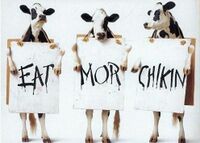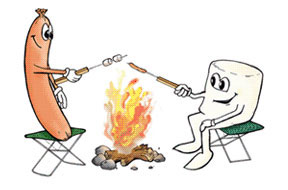On a stick

“When I see a pretty girl walking down the street, I think two things. One part wants to be real nice and sweet, and the other part wonders what her head would look like on a stick.”
“When I see a handsome young merchant marine walking down the street, I only think about one thing - how I would look on his stick.”
On a stick (pronounced "onna stick") is one of the most inspired marketing gimmicks of the modern world, with its influence felt, if not seen, worldwide (the stick is generally hidden inside whatever it is that was placed on the stick).
Executive Summary
Everything's better on a stick.
Food on a stick
It is here that the on a stick phenomenon began, and for purists, this continues to be the mecca of stickdom.
"On a stick" was invented by... some guy, at some point in time. Not recently. It was some time ago. Does it really matter? It's peripheral to the story.
The idea — possibly patented in 1189, if it makes you feel better to have some kind of date to cling to — was to place food and other items on a stick. Get it? Food that you would normally see on a plate — on a stick — making it much easier for Crusaders to literally eat on-the-run from beasts that held the Holy Lands.
Getting back to the story, the guy had these hot dogs that weren't selling. Were there hot dogs in 1189? It might have been ice cream. It was definitely something edible, but not something that people were typically accustomed to seeing on a stick, let alone eating from a stick. And that's just it, you see? The novelty. Yes, perhaps it was ice cream.
In any event, it turned out that people were really quite ensnared by the idea of eating candy from atop a stick, and that guy was somehow able to sell all his apples. They might have been candy apples at that. Do you care?
The choc ice
The urge to put ice cream on a stick is perhaps as old as all humanity, or if not all humanity, then at least the very old ones. Initially, ice cream was put on a stick in its pure state, but this led to a problem commonly known as "ice cream sliding off a stick". The very worst nightmare, for any Victorian gentleman, was coming home with ice cream all over his trousers. In some cases it led to imprisonment without trial. So, ice cream on a stick fell in popularity, until...
...some guy came up with the idea of coating the ice cream in a smooth, crispy shell of delicious chocolate — perfect for bringing back memories of innocent childhood days swimming in dreamy pools of, well, something — possibly chocolate — possibly not. And so the choc ice was born. They were hugely popular... for a week, and then another problem was discovered. While most of the choc ice could be eaten in relative safety (as long as the correct protective clothing was worn) — the very last bit always fell off the stick. No matter how hard people tried, if they ate one half of the last bit, the other half would fall off.
That guy countered this problem by printing jokes on the sticks of choc ices, so that people could laugh off the crushing disappointment of having some of their food fall off a stick onto the ground. This solution, while novel, and brilliant, is also pretty stupid, as is generally acknowledged in the stick community. But there will always be a hero. A hero ready and willing to step up to the plate and keep on innovating until we get the damned ice cream to stay on the damned stick once and for all.
Information on a stick
Jokes on ice cream sticks, it turned out, would be the dawn of a new era in stickdom: Stickformation technology.
It progressed very simply. They say that Necessity is the mother of Invention. Necessity must not have been terribly religious, because Invention has been the unwed mother of a lot of others since. Maybe she's got a sexual addiction. Or it's possible that she just uses sex to get love. A lot of good people make that mistake.
Whatever the story was there, some time later there were a group of protesters carrying signs, and marching around complaining about something. It might have been a labour dispute. Or possibly a civil rights issue. Maybe it was to protest the closure and pending demolition of the neighborhood "Big Boy" restaurant (see how it all comes back to food?) in order to construct a new highway. Does it matter?
No. Not really.
Anyway, people's hands were getting cut on the sign edges, and they were too low to the ground to be readable. Just then, someone shouted, "Hey! What if we put them on sticks?" And voilà, the protest sign was invented. Information suddenly became easily portable, and reversable, with messages on both sides of the sign. Not only that, but the extra leverage afforded by a stick-mounted sign made protest riots a lot more bloody... and more interesting to watch.
Today, protest signs are still the preferred means of communicating strike demands — they look great on television, just like the blood — though signs are far from being the only variation of this concept.
That nerd that you try to avoid talking to would probably love to tell you all about the USB stick he carries in his pocket protector that can dual-boot Windows XP and Linux from any computer with a USB port. But you should probably continue to avoid him at all costs.
Animals on a stick
Rabbits are great in the forest, but less so indoors. They have this irritating habit of hopping all over the place, chewing on important documents and furniture, and leaving their little pellet droppings everywhere. Then, seemingly out of nowhere, someone thought, "Hey! What if we killed it and mounted it on a stick?"
And so, taxidermy was born. Rabbits everywhere ceased hopping and nibbling on cherished porn collections carefully hidden under the desk in weathered cardboard boxes marked "income tax", and began sitting alertly on mantlepieces worldwide, with metal rods carefully inserted into their rectums to prevent sagging.
Then, at some point, some other person noticed an attractively mounted squirrel paddling a canoe and thought, "Seems like a perfectly good waste of meat to me." And he went on to develop and market the rotisserie. Was that Ron Popeil? He's never spit-roasted a squirrel on an infomercial, but then the idea is to appeal to bland American tastes.
Did you notice how it all comes back to food?
Walrus on a stick
In 1923, the great Norwegian inventor and tap dancer, Thor Lingus, had the idea of putting walruses on a stick. Up to that point, walruses had not really penetrated the market sector for convenience foods, mostly because they preferred to spend their time laying around on ice floes, grunting and scratching. No one gets far in marketing if they spend all their time doing that — apart from Michael Bolton of course, but then he's got unique hair.
Thor sent a team of walrus capturing experts to wherever walruses happened to live at the time. They brought some walruses back to New York and Thor set up a vending cart in Times Square. He had decided to use cocktail sticks because they are light, portable and allow customers to pick walrus from their teeth after the meal. When the consignment arrived, however, Thor realised his terrible miscalculation. All he had seen up to that point were photographs of walruses, and he had thought that they were much much smaller — about the size of a golf ball.
Still, Thor wasn't a quitter. With the help of ten other people, he managed to get one walrus on a cocktail stick and sold it to his first customer for $100, which was a lot of money in those days. Soon, Times Square was filled with city folk all staggering about under walruses and a number of traffic accidents occurred as a result. The police were called and Thor legged it. The experiment has never been repeated, except with hot dogs.
So, in fact, walruses are not better on a stick. Ignore this entire section, and accept our apologies.
People on a stick
Stickin' it to the man has been a popular pastime, particularly in the Middle East, since the advent of crucifixion. Sadly, dangling from the big "t" has fallen out of favor these last two millennia after some guy was wrongfully executed. A shame, really — about the decline in popularity.
Still, few would disagree that nothing looks quite as good on a stick than an enemy (or a framed facsimile) — be it a horde of voles or merely that guy who never has the correct change at the corner shop. Those few that do disagree, of course, will usually change their opinion quite rapidly once a stick is inserted. Within hours, you will have a bunch of new friends, and even better than that, you will always know where to find them.
In these days of enlightened plutocracy, of course, putting people on sticks is largely frowned upon. But back in the 1400's — boy was it ever boomtime in stick town. Whole forests were turned into poles for human canopies. Perhaps the most notorious exponent of sticking it to 'em was Vlad Tepes, the Romanian landlord and inspiration for the Dracula legend. Vlad would often put an enemy, some cheesy nibbles, cherries and marshmallows all on one stick — and then have a party.
Then there are pole dancers – agile young women who bring the fun of their sport to those who seldom see anything other than the inside of nightclubs. To hurl themselves around the pole at break-neck speed takes fine muscle tone, a sense of rhythm, nine inch platform shoes and a crisp twenty dollar bill. For an extra ten, the champion twirlers will flip themselves upside down on the pole as well. Good show! There you have it – good clean fun.
Other things that are better on a stick
- Cantilever houses - Built on hillsides overlooking earthquake faults in California.
- Carrots - Not as food, but incentive.
- Daredevils - Pole sitters are always popular attractions.
- Feet - Stilts are great fun during activity time at the rest home - helps to get that old heart a pumping.
- Flags - For obsessive patriot-types hung up on waving their symbol of worldwide oppression, double standards, and human rights violation.
- Pee - If you're under 12, it makes a great weapon for scaring off icky girls and stuff.
- Poop - See pee.
- Sticks - A mutual improvement for all involved, sometimes called a tree.
- Stick insects - That'll show them.
- Your dog
| Featured version: 21 May 2006 | |
| This article has been featured on the main page. — You can vote for or nominate your favourite articles at Uncyclopedia:VFH. | |





